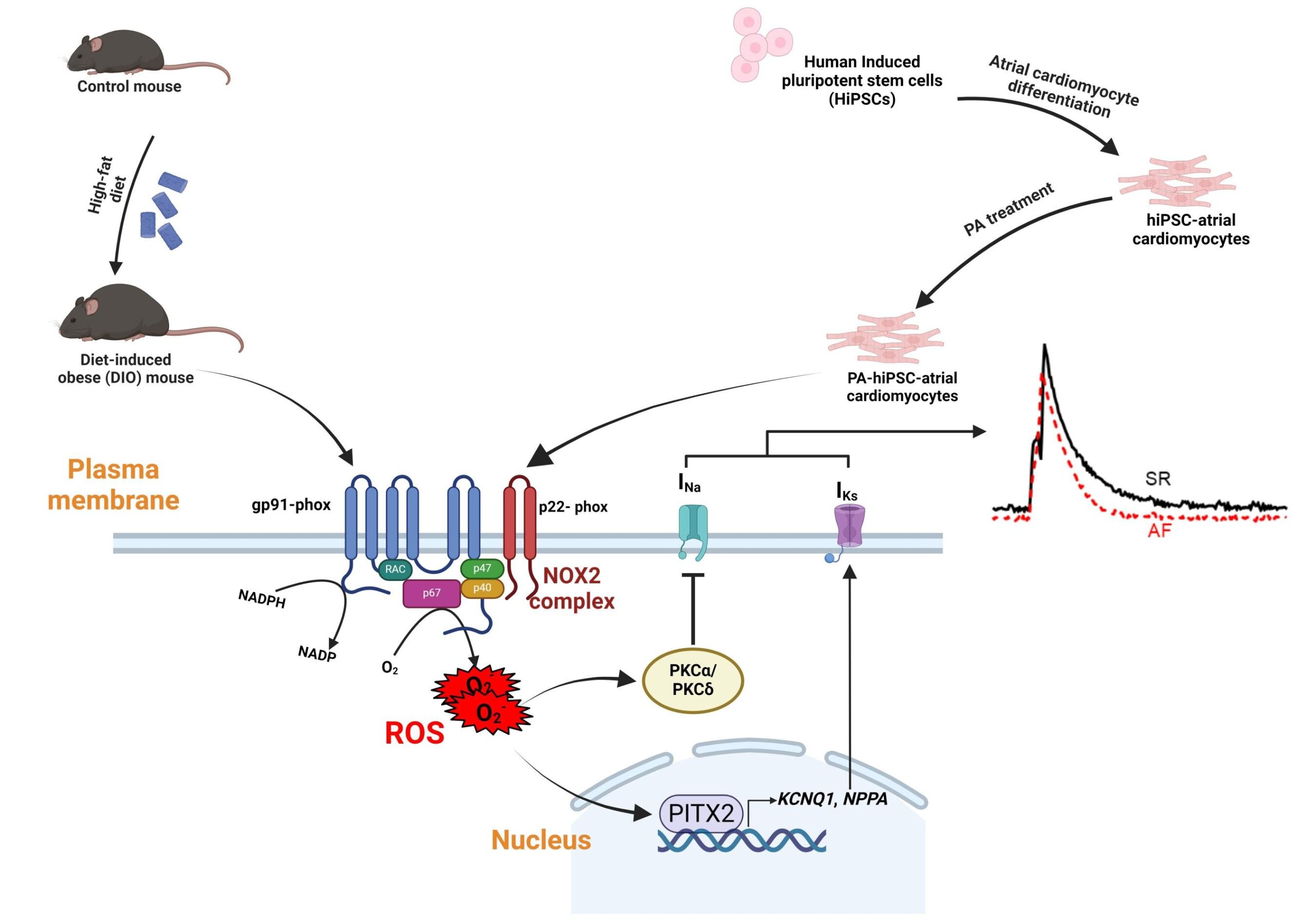
A cellular link between obesity and atrial fibrillation—a heart condition that afflicts over 33 million people worldwide—presents a promising target for new therapies, researchers from the University of Illinois Chicago report.
Obesity is among the leading causes of atrial fibrillation, an irregular heart rhythm that can lead to heart failure and stroke. But scientists still don’t know how high levels of body fat cause this heart condition.
In a new study published in The Journal of Clinical Investigation, UIC researchers identified a cellular pathway essential to obesity-induced atrial fibrillation. Experiments in cells and mice found that blocking a key enzyme, called NOX2, in this pathway could both prevent and reverse changes in heart structure and function caused by a high-fat diet.
“A drug that blocks this enzyme may have two uses,” said Dr. Dawood Darbar, chief of cardiology and professor of medicine and pharmacology at UIC and senior author of the paper. “We could use this drug to prevent the development of atrial fibrillation in individuals who have obesity but who haven’t yet developed atrial fibrillation. For those who already have obesity and atrial fibrillation, we can use it to treat them and prevent the progression of the disease.”
The College of Medicine research team, led by UIC postdoctoral scholar Arvind Sridhar, looked at a process called oxidative stress that’s believed to link obesity and atrial fibrillation. Under oxidative stress—which can be caused by obesity, diabetes and other conditions—factors called reactive oxygen species accumulate in cells and cause damage.
Antioxidants, including vitamins and minerals found in fruits and vegetables, combat oxidative stress. But antioxidant treatments for atrial fibrillation have shown mixed results.
“Some of these studies were positive, some were negative, some were neutral, and we didn’t understand why,” Darbar said. “Now it seems the reason why antioxidants didn’t work in atrial fibrillation is because they didn’t target the specific pathway that caused the oxidative stress.”
The UIC team identified that pathway by examining heart tissue taken from patients during surgery. They found that the enzyme NOX2, which produces the damaging reactive oxygen species, was higher in obese patients compared to patients with a lower body mass index.
“As the BMI of the individual increased, we saw an increased severity of atrial fibrillation,” Sridhar said. “We also saw a similar increase in the expression of NOX2 as the BMI increased, which tells us that the two are intrinsically related.”
Next, they turned to a mouse model where the gene for NOX2 was removed. While normal mice that ate a high-fat diet developed atrial fibrillation, mice without the NOX2 gene did not. Normal mice treated with a drug that blocks NOX2 activity also did not develop the heart condition.
A third experiment used heart stem cells taken from atrial fibrillation patients using an innovative system developed by Darbar and Salman Khetani of the UIC College of Engineering. When they treated these cells with the NOX2 inhibitor, the level of reactive oxygen species dropped, and the abnormal electrical activity associated with atrial fibrillation was eliminated.
Because the drug used in the study’s cell and animal experiments is not FDA-approved, the researchers will search for and test other compounds that block NOX2 before beginning clinical trials in patients.
“Because obesity is becoming so common, I think this finding will have a tremendous impact,” Darbar said.
In addition to Darbar and Sridhar, UIC co-authors of the paper include Jaime DeSantiago, Hanna Chen, Mahmud Arif Pavel, Olivia Ly, Asia Owais, Miles Barney, Jordan Jousma, Sarath Babu Nukala, Dr. Khaled Abdelhady, Dr. Malek Massad, Lona Ernst Rizkallah, Sang Ging Ong and Dr. Jalees Rehman.
More information:
Arvind Sridhar et al, Modulation of NOX2 causes obesity-mediated atrial fibrillation, Journal of Clinical Investigation (2024). DOI: 10.1172/JCI175447
Citation:
Breaking the link between obesity and atrial fibrillation with a new cellular target (2024, September 4)
retrieved 4 September 2024
from https://medicalxpress.com/news/2024-09-link-obesity-atrial-fibrillation-cellular.html
This document is subject to copyright. Apart from any fair dealing for the purpose of private study or research, no
part may be reproduced without the written permission. The content is provided for information purposes only.



